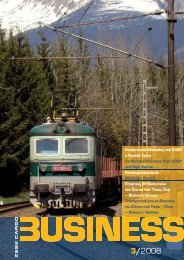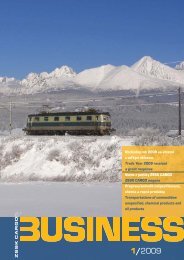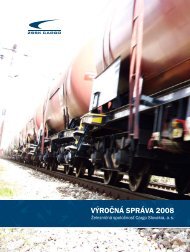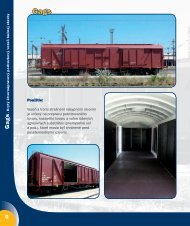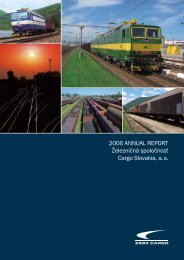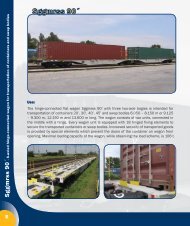CARGO BUSINESS 2-10.indd - ZSSK Cargo
CARGO BUSINESS 2-10.indd - ZSSK Cargo
CARGO BUSINESS 2-10.indd - ZSSK Cargo
- No tags were found...
You also want an ePaper? Increase the reach of your titles
YUMPU automatically turns print PDFs into web optimized ePapers that Google loves.
upper edges of walls or stanchions of the wagon. In this context, wemay face the problem of adequate securing the trunk wood againststress during transport. Wood is located in the space above the fixedparts of the wagon. What are the options? In particular, we must takeinto account the basic principles:- Diameter of wood loaded using the flatrack loading method cannotexceed the diameter of wood forming the flatrack. It can be as large asthe diameter of wood forming the flatrack.- the curve height is 1/3 of the loading width maximally.<strong>Cargo</strong> above the walls or wagon stanchions is not secured by fixedparts of the wagon and it is one of the main reasons why we haveto pay special attention to this part during loading and securing. Itmust be sufficiently secured against movement in lengthwise andtransverse direction. Loading and securing must resist the effectsof stress during transport (shock, displacement, acceleration anddeceleration when starting ...). It is possible to ensure that theseconditions are complied with by lashing the cargo (in lengthwisedirection) and by using the correct flatrack loading method(transverse direction).Flatrack loading method is a way to load the cargo of cylindrical shapein stacks, where the top pieces are loaded and secured in a flatrack,created by pieces placed underneath.Principles of Flatrack Loading MethodGeneral principles of the correct flatrack loading method:- Diameter of trunk loaded using the flatrack method cannot exceedthe diameter of trunks, creating the flatrack,- Unequal or unequally thick heavy ends of trunks must be alternated,Úhrada za použitie železničnej infraštruktúry po novomNew charging system for the use of railway infrastructureDňa 1. septembra 2010 nadobudol účinnosť výnos Úradu pre reguláciuželezničnej dopravy o regulačnom rámci pre určovanie úhrad zaprístup k železničnej infraštruktúre. V súlade s týmto Výnosom podľazákona o dráhach č.513/2009 Z. z. manažér infraštruktúry ŽSR predložildo 30. 9. 2010 návrh na určenie maximálnych úhrad za minimálnya traťový prístup k servisným zariadeniam na obdobie začínajúce 1. januárom2011. V súlade s už publikovanými informáciami úhrady budúurčené len na základe variabilných ekonomicky oprávnených nákladovvynaložených na prevádzku vlaku na železničnej infraštruktúre za účelomposkytovania služieb v rozsahu minimálneho prístupového balíkaa traťového prístupu k servisným zariadeniam, a to vo výške maximálne25 % z celkových ekonomicky oprávnených nákladov manažérainfraštruktúry bez možnosti uplatnenia zisku. Schematicky to vyjadrujepriložený obrázok, ktorý sme uverejnili už v predošlom čísle nášho časopisu<strong>ZSSK</strong> <strong>CARGO</strong> Business na strane 22, avšak s chybou. Autorovitextu Ing. Miroslavovi Garajovi z oddelenia strategického riadenia ŽSRsa ospravedlňujeme a obrázok uverejňujeme v správnej podobe.(r)A new Decree of the Railway Regulatory Authority on regulatoryframe for charging for the use of railway infrastructure came intoforce September 1, 2010. September 30, 2010, according to thisDecree and in compliance with the Railway Act No.513/2009 Coll,infrastructure manager ŽSR presented a proposal of maximum pricesfor a minimal and track access to serviceing equipment for the periodstarting January 1, 2011. In accordance with published information,these prices will be stated on the basis of legitimate variable costsincurred for a train operation on railway infrastructure in order toprovide services in the scope of minimal access package and trackaccess to serviceing equipment, and that at the amount of maximum25% of all costs incurred by infrastructure manager, with no margin32/33- Trunks of different lengths, weights and diameters must be loaded ina way that heavier and long trunks are at the bottom,- Stacks loaded using the flatrack loading method must be completedin the shape of curve, thereby improving the efficiency of lashing ontothe wagon,- Flatrack loading method can only be used for wood which is straightand with firm bark along the entire trunk. This will result in greaterstability of the stack and at the same time, in correct roundness in theupper part.Before we begin to load,we must take into accountthat using the flatrackloading method – above thestanchions and any fixedparts of the wagon – meansthat the wood is fixed onlyby itself and by lashing.Any underestimation of theabove-mentioned principlescan result in undesiredconsequences not only inthe form of material damage,but also in terms of harm tohuman health.Kristína JÁNOŠOVÁOperations andTransportation Sectionapplicable. This can be schematically seen at the attached picture,which was published also in the previous issue of our magazine <strong>ZSSK</strong><strong>CARGO</strong> Business on the page 22, however, there was a mistake.Hereby, we would like to apologize to the author of the article, Mr.Miroslav Garaj, from the department of strategic management of ŽSRand we publish the corrected picture.(r)Systém spoplatňovania ŽDCThe system of charging for acces to rail infrastructureEkonomicky oprávnené náklady (EON)/Legitimate costsSúčasný stavCurrent statusNeinvestičná dotácia štátuNon-investment state grant(= EON – Poplatokza použitie ŽDC)(= Legitimate costs -(Charges for acces to railinfrastructure)Poplatokza použitie ŽDCCharges for acces to railinfrastructureStav od 1. 1. 2011Status from 1.1.2011Fixné nákladyFixed costs(Úhrada zo štátnehorozpočtu)(Remittance from thenational budget)Variabilné nákladyVariable costs(Poplatok za použitie ŽDC)(Charges for access to railinfrastructure)Ekonomicky oprávnené náklady (EON)/Legitimate costs




